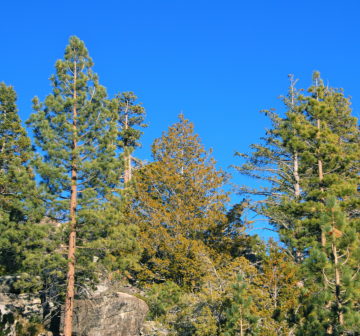Cupressaceae
Cupressus arizonica var. montana
Endemic to Baja California in Mexico where the main threat is likely to be from an increase in the severity and frequency of fires due to fire suppression policies, coupled with the likely impacts of climate change.
Human Uses
Rarely cultivated
References and further reading
- Adams, R.P., Bartel, J.A. & Price, R.A.. (2009). A new genus, Hesperocyparis, for the cypresses of the western hemisphere. Phytologia 91(1):160-185.
- de Laubenfels, D.J. (2009). Nomenclatural actions for the New World cypresses (Cupressaceae). Novon 19(3):300-306.
- Farjon, A. (2005). A Monograph of Cupressaceae and Sciadopitys. Royal Botanic Gardens, Kew.
- Farjon, A. (2013). Cupressus arizonica var. montana. In: IUCN 2013. IUCN Red List of Threatened Species. Version 2013.1. . Downloaded on 05 July 2013.
- Little, D.P. (2006). Evolution and circumscription of the true cypresses (Cupressaceae: Cupressus). Systematic Botany 31(3): 461-480.
- Adams RP, Bartel J, Terry R, Callahan F & J Bisbee. 2014. Taxonomy of Hesperocyparis montana, H. revealiana and H. stephensonii: Evidence from leaf essential oils analyses and DNA sequences. Phytologia 96(2): 71-83.
- Bojorquez-Tapia LA, Cueva H, Dıaz S, Melgarejo D, Alcantar G, Solares MJ, Grobet G & G Cruz-Bello. 2004. Environmental conflicts and nature reserves: redesigning Sierra San Pedro Martir National Park, Mexico. Biological Conservation 117: 111-126
- Maerki, D. 2015. Note on the conservation status of Cupressus montana. Bulletin of the Cupressus Conservation Project 4(3): 133-136
- Meko DM, Touchan R, Diaz JV, Griffin D, Woodhouse CA, Castro CL, Carillo C & SW Leavitt. 2013. Sierra San Pedro Mártir, Baja California, cool-season precipitation reconstructed from earlywood width of Abies concolor tree rings. Journal of Geophysical Research: Geosciences 118: 1660-1673
- Minnich, R., M. Barbour, J. Burk & J. Sosa-Ramirez. 2000. Californian mixed-conifer forests under unmanaged fire regimes in the Sierra San Pedro Martir, Baja California, Mexico Journal of Biogeography 27: 105-129
- Rivera-Huerta, H., H.D. Safford, and J.D. Miller. 2015. Patterns and trends in burned area and fire severity from 1984 to 2010 in the Sierra de San Pedro Mártir, Baja California, Mexico. Fire Ecology 12(1): 52-72
- Thorne, R., R. Moran & R. Minnich. 2010. Vascular Plants of the High Sierra San Pedro Mártir, Baja California, Mexico: an Annotated Checklist. Aliso 28(1): 1-50











